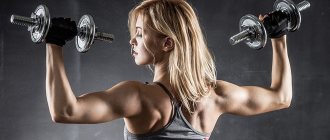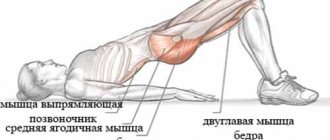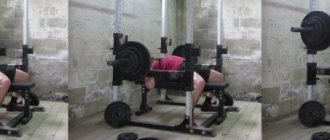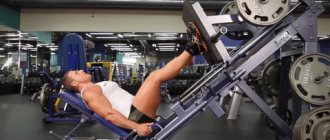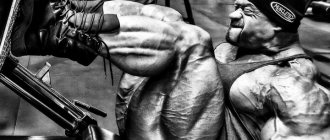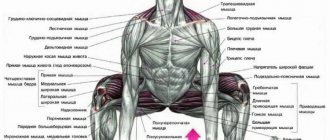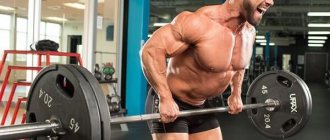Author: Nikolay Borisov - coach, Russian champion in powerlifting Place in the ranking of authors: 14
(become an author) Date: 2017-06-03 Views: 14,967 Rating: 4.9
| All articles by the author >> | Medals articles >> |
Articles are loading...
Visit the website of the author of this article
What are simulators made for?
Initially, the simulators were supposed to help people with disabilities. For example, it is very difficult for a person with poor coordination due to a congenital disease to learn how to squat with a barbell. Smith's frame will allow him to squat, greatly reducing the risk of falling. If someone manages to break an ankle or two, the simulators will allow you to train your casted legs by doing roll-ups and fly-outs.
Sometimes healthy athletes need exercise machines to work out lagging muscles in isolation. The simulator may also be needed for “finishing”. When, after 6-7 sets of pull-ups, you can no longer do even five repetitions, block pulls from above will help out, you can do another 2-3 sets of 10-12 times.
However, over time, exercise machines began to be used instead of free weights in cases where their effectiveness is negligible.
Why fitness trainers love exercise machines.
1.
You can sit or lie on them and take selfies.
2.
The technique of exercises on simulators is an order of magnitude simpler than the technique of exercises with free weights.
3.
It is easier to rearrange the weight on a machine than on a barbell.
4.
The fitness person thinks that a modern simulator is the pinnacle of engineering that will bring him closer to his desired goal.
5.
You can feel cool by pulling all the tiles. Nothing will work with a barbell loaded to the brim.
Why instructors love simulators.
1.
Less time will be spent teaching the client the technique of the exercises than doing exercises with free weights.
2.
Less risk of injuring clients.
3.
There are fewer discs and dumbbells scattered around the room.
About efficiency.
If you have not been involved in physical education and sports for a long time, perhaps the coordination of your movements is not sufficient to work with free weights and it is more advisable to start with exercise machines. When you start exercising on machines, you will feel muscle pain in the first weeks. This means your muscles have received sufficient load. But already in the second month of training on simulators, the effect becomes less noticeable.
Of course, some simulators are necessary for a full workout. As a rule, these are the simplest of them: upper and lower blocks, hyperextension machines. There are successful machines that simulate a seated press, which work the front delts better than with free weights. There are also other useful devices. However, most of the “furniture” in fitness centers only distracts people from proper training.
If the goal of your training is to lose weight: exercises with or without free weights, just with your own weight, will allow you to burn more calories, since they involve more muscles due to their complexity, compared to exercise machines.
If the goal of your training is to gain muscle mass: the criterion for the effectiveness of the exercise is the degree of pain 2-3 days after training. Feelings during exercise and in the evening after exercise can be deceiving. Microtraumas of muscle fibers cause long-term pain, sometimes up to 5-6 days. It usually begins the next day after training, sometimes after 2-2.5 days.
Based on this, you can independently determine the effectiveness of each exercise. For the purity of the experiment, you need to perform only one exercise on a given muscle in 5-6 approaches close to failure and observe the sensations in the muscles for several days.
The experiment with each exercise must be repeated at least 3 times, sometimes the muscle is not pumped for unknown reasons, the body is a complex thing.
What is the secret of his popularity?
If you believe the statistics, then lying leg curls are one of the most favorite exercises among the female half of the population. And this is not surprising, given that every girl wants to excite men with her curves from behind, and this is especially true for her legs, which should not only be slender, but also toned. Therefore, the main emphasis must be placed on these muscles. In addition, as mentioned above, such a simulator is an indispensable attribute of any gym.
Leg press
Why it's dangerous: Your legs are strong enough to support the full weight of your body every day. But what happens in this simulator? In this position, the weight rests on your lower back and you are at serious risk of lumbar disc herniation. In addition, when performing movements, the stabilizing muscles of the hips, buttocks, and shoulders are not used. Therefore, the activity will not only be ineffective, but also dangerous.
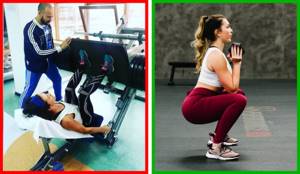
Tip: Squats with dumbbells or kettlebells can be an excellent substitute. Pressure in the lower back is partly relieved by putting pressure on the arms. Additionally, dumbbells force you to maintain a specific position while using a large number of muscles at the same time. Sometimes a much lighter activity can burn more calories.
What muscles are involved?
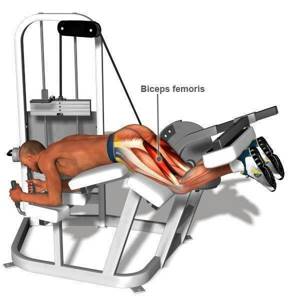
Bending the legs in a supine position occurs thanks to the muscles of the hamstrings, and more specifically, the biceps femoris, semimembranosus and semitendinosus muscles. Also, during the lesson itself, the work of both the hamstring biceps and the function of leg flexion at the knee joint is completely isolated.
If we talk about the knee tendons, then we need to take into account that they consist of 3 main muscles:
- Biceps femoris muscle.
- Semitendinosus.
- Semi-membranous.
There are currently only 2 exercises that incorporate the use of hamstrings into your workouts. An example is the Romanian deadlift, which uses the hamstrings through the hip joint, making the exercise more like a stretch.
Advantages
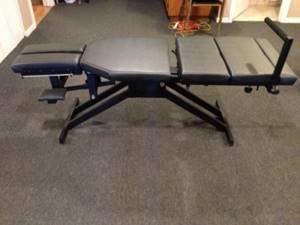
Lying leg curls, like every activity, are not without their benefits. In this case, these include the fact that it is completely isolated and completely focused on toning the buttocks and the back of the legs. It is also worth noting that this exercise can be used to give both volume and definition to the hamstrings. Other advantages include:
- Ease of implementation.
- Variety of variations.
- Increase strength in other standard leg exercises.
In addition, as numerous surveys among the male population have shown, this is a rather difficult workout.
I would also like to say a few more words about the fact that leg bending and extension is a very important exercise, which provides a kind of balance between the front and back of the leg. This balance not only plays an important role from an aesthetic point of view, but also from a preventive point, since the likelihood of injury that could be caused by an imbalance is significantly reduced.
Abdominal exercises
According to Dr. Stuart McGill, a professor at the University of Waterloo and a world-renowned specialist and expert on back biomechanics, doing crunches puts a lot of stress on the back and leads to injuries and problems with the lower back, in particular bulging spinal discs.
Based on research, Dr. McGill concludes that the lower back has a certain limit of flexion and extension, after which the tissue wears out and the risk of injury increases greatly.
Raising the torso
Raising your torso on an incline bench or on the floor is considered a dangerous exercise for the lower back. During sit-ups, not only the rectus abdominis muscles are tensed, but also the iliopsoas muscles, which are part of the group of internal pelvic muscles.
The iliopsoas muscles compress the lumbar vertebrae during lifting, and with excessive and constant load during crunches (while working out at home, many like to set personal records: 3 sets of 30–40 times, until the abdominal muscles fail), the pressure on the vertebrae increases, which threatens lumbar injuries.
In addition, body lifts are contraindicated for people with sedentary work. During the day, due to the sitting position and tilt of the body forward, the anterior part of the lumbar spinal discs experiences serious stress.
During lifting, you load them even more: the front part of the discs is compressed, and the back part is stretched and injured. Therefore, after repeated repetitions, people often feel pain in the lumbar region.
An excellent replacement for dynamic exercises is the plank with isometric abdominal tension. This exercise eliminates compression of the spine and numerous bends and at the same time perfectly trains the rectus abdominis muscles.
Crunches
Ab crunches do not involve a full lift of the body, so this exercise can be considered more gentle on the lower back. However, this reveals another problem - excessive tension in the neck and shoulders.
In addition, by twisting, you shorten the rectus abdominis muscle, which performs not only the function of flexion and extension of the body, but also its stabilization. The shortened abdominal muscle pulls the chest down, the shoulders drop, and the head comes forward.
Leg raises
You should not perform this exercise if you have weak rectus abdominis muscles. When you perform leg raises, part of the load is placed on the iliopsoas muscle.
With undeveloped abdominal muscles, the iliopsoas muscle becomes excessively tense and pulls the spine along with it. As a result, you may experience displacement of the lumbar vertebrae.
Therefore, before performing this exercise, it is necessary to strengthen the rectus abdominis muscles.
Twisting with a side turn
This exercise is considered especially effective for pumping up the oblique abdominal muscles, but it is quite dangerous for the spine. Just as during sit-ups, the front part of the spinal discs is compressed, and turning the body increases the load.
How to do this exercise correctly

Although lying leg curls are considered one of the simplest exercises, there are still cases of doing it incorrectly, which can lead to the most unpleasant consequences in the future. Therefore, in order to minimize the occurrence of such situations, we will consider the technique of its implementation.
First of all, we approach the simulator and, using the lower roller, set its position in accordance with our height. After this, we lie face down, placing our legs under the bolster (approximately on the same plane as our ankles) and placing them parallel to each other. Particular attention should be paid to ensuring that the knees do not hang off the bench, and that its bend is located at the waist. Next, pressing your pelvis tightly against the machine, we grab the handrail with our hands, directing our gaze to the floor, and strain our abs and buttocks. This completes the preparation for the lesson.
Arm exercises
Bench press
The shoulder joint is poorly adapted to such a load due to its anatomical features.
When you raise your arm, the acromion, the end of the shoulder blade, rubs against the rotator cuff, causing irritation or damage to its tendons (impingement syndrome).
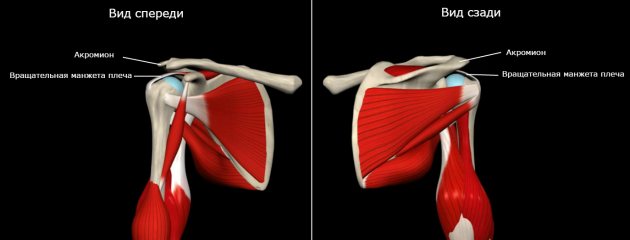
Acromion and rotator cuff
Raising your arms with dumbbells up
The exercise is aimed at working the trapezius and rhomboid muscles, as well as the triceps and deltoid muscles of the shoulder.
The main load goes directly to the shoulder muscles, so there is a danger of overworking them and getting pinched nerves. In addition, there is the above-described problem with the impact on the rotator cuff and the risk of impingement syndrome.
The dumbbells are raised at arm's length to shoulder level. It is important to avoid rotation of the shoulder joint and lift the dumbbells alternately with your left and right hands, and not with both hands at the same time. This relieves stress on your back.
During this exercise, the arm is not raised so high that it overloads the shoulder muscles. In addition, the acromion does not reach the rotator cuff, which eliminates tendon damage. At the same time, the exercise uses the same muscle groups as lifting dumbbells up: deltoid, trapezius, serratus anterior, rhomboid.
French press
This is another type of non-physiological load that practically never occurs in everyday life. During this exercise, a large load is placed on the elbow joints, which are not ready for this. As a result, the risk of elbow injury increases. Personal experience suggests that this is so: clicking and pain in the elbows necessarily accompanied this exercise.
Leg bending while lying down in a machine
After the starting position is accepted, we begin the exercise. So, first of all, we take a deep breath, hold our breath and, without lifting our front thighs from the bench, we begin to pull the roller towards the buttocks with powerful movements. After this, we exhale when we have passed one of the most difficult amplitudes. We linger for a few seconds in the highest position and very slowly, without losing control for a second while inhaling, we return to the starting position. Next, we repeat the same procedure a certain number of times.
Bends to the side with a gymnastic stick or turns
Why? You may think that this way you are strengthening your core muscles or burning fat, but in reality you are not. In reality, when you work with a weight behind your neck and start twisting and turning the barbell, there isn't that much resistance. It's better to train against gravity.
What to replace it with? Side plank static or dynamic. This is a gravity-resistance exercise that effectively works your muscles.
Tricks of execution

To get maximum effect, it is recommended to adhere to the following rules:
- While performing, hold the handles of the machine firmly.
- Under no circumstances lift your pelvis from the arch of the benches.
- Bend your legs until they are almost completely in contact with your buttocks.
- To maintain the load on the muscles, do not fully straighten your knees when they are at their lowest point.
- The upward movement is slightly faster than the downward movement.
- Do not slide your hip or pelvis on the bench.
- Make sure that your knees do not hang over the bench.
- Stretch your hamstring after completing each set.
Remember, it is strictly forbidden to perform this exercise if you have a medium or large belly.
Calf raise against all machines
I tried training my lower legs on different machines, standing and sitting. I never felt a serious effect. Often due to uncomfortable or slippery foot rests, sometimes for reasons I don't understand.
Only by doing calf raises, standing on a raised platform (with a wooden or rubber surface) against a support (usually a wall bar), I almost always get muscle pain. To do this, you need to follow several rules: smooth lowering, several times slower than lifting; lowering to failure with maximum muscle relaxation; raising the heel to the maximum height and holding it at the top point; changing legs without rest for all sets, usually from 3 to 5. Track and field athletes will need to hang a kettlebell on their belt. Large weights are not needed; as the number of repetitions decreases, the effect of the exercise decreases. Hands should hold onto a wall bars or other support. Otherwise, you will have to think about maintaining balance, which will prevent you from concentrating on the execution technique. For this reason, I consider calf raises with a barbell on the back, which some people demonstrate on the Internet, to be completely unacceptable. Press your free leg close to your working leg to avoid unnecessary vibrations. In the video, I sometimes move it to the side so that you can better see the work of the muscle. The right heel drops less than the left due to the fracture, I’m not messing around.
The exercise should be done in shoes with flexible soles and good grip. Perform the exercise no faster than shown in the video and the lower leg will work.
Exercises at home
As practice shows, you can build up slender legs and firm buttocks without going to the gym. All you need is desire and persistence. In addition, the fundamental difference between classes at home is that they can take place whenever you want and for as long as you want. Plus they are completely free.
There are home exercises that you can do regardless of your fitness level. For example: we stand straight and place our feet slightly wider than shoulder level. We hold our hands on our belts, and “look” in different directions with our toes and knees. After this, we slowly squat as low as possible, remembering to keep our back straight and not bend our knees to the side. In addition, when performing this activity, you need to ensure that the stomach is pulled in and the muscles of the buttocks are tense. The lifts and squats themselves should be done very smoothly.
Ab exercises
Why? Simply because they are not that effective. Research has confirmed that abdominal exercises are less effective at stimulating muscle fibers than exercises aimed at stabilizing the spine (planks).
What to replace it with? Plank (read “Keeping the Plank: A Set of Simple and Effective Exercises for a Beautiful Body”). By doing this exercise, you will use more core muscles than an ab crunch. In addition, doing a plank will prevent you from straining your back.
